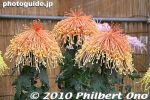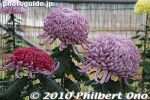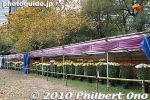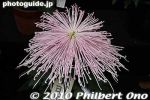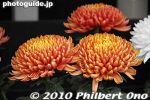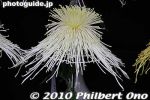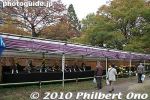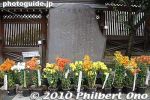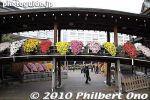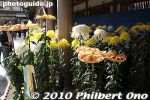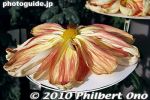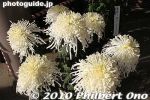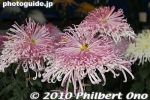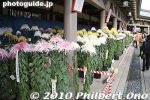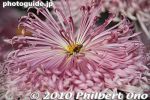 Image search results - "kiku" Image search results - "kiku" |

During most of Nov., the annual Tokyo-to Kanko Kikka Taikai or Chrysanthemum Show is held. An incredible variety of this revered flower is on display. One of Tokyo's best chrysanthemum shows in autumn.
|
|

The Chrysanthemum Show was held in this grassy area next to the tennis courts. There were a good number of shacks housing the flowers.
|
|

The Tokyo Chrysanthemum Show in Hibiya Park was a competition among world-class growers and breeders. The best flowers receive various award ribbons.
|
|
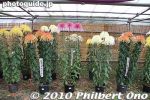
There are numerous varieties of the chrysanthemum and breeders create new species each year. It's like orchid breeders.
|
|

The results can be quite spectacular or subtle. Chrysanthemums are called "kiku" in Japanese. The ordinary chrysanthemums sold by your neighborhood flower shop are mainly used for funerals or memorial services.
|
|
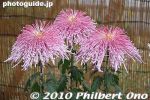
I was told that most breeders are older folk, in their 60s and 70s. Young people are not taking it up.
|
|
|

The breeders/growers belong to chrysanthemum clubs or associations which participate in competitions like this one.
|
|

The shapes, sizes, and colors are so incredibly varied.
|
|
|

Tokyo Chrysanthemum Show in Hibiya Park.
|
|
|

More racks of chrysanthemums.
|
|
|
|
|
|
|
|

Bonsai chrysanthemums.
|
|
|
|
|
|
|
|

This is the original species of chrysanthemum. The Imperial family crest is also based on this species of chrysanthemum which was introduced to Japan from China.
|
|
|

Two-tone flowers are also quite common and very beautiful.
|
|
|
|
|
|
|
|
|
|
|
|
|
|
|
|
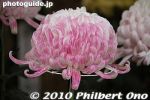
Very beautiful and subtle color tones.
|
|
|
|
|
|
|

Bonsai chrysanthemum.
|
|
|
|
|

Bonsai chrysanthemum modeled after Hakone.
|
|
|
|
|
|
|
|
|
|
|
|
|
|
|

Spikey flower.
|
|
|

This looks more like something you would find in a tropical ocean.
|
|
|
|

Chrysanthemum Show in Hibiya Park, Tokyo.
|
|
|
|
|
|

Golden chrysanthemums were impressive.
|
|

Golden chrysanthemums.
|
|
|
|
|
|
|
|
|
|
|
|
|

The original chrysanthemums.
|
|
|
|

Bonsai chrysanthemum.
|
|

Steps going up to Yushima Tenjin (Tenmangu) Shrine. This is the gate closest to Yushima Station on the Chiyoda subway line. The steps are accented by pots of chrysanthemums.
|
|

In 2010, Yushima Tenjin Shrine's 32nd Chrysanthemum Festival (Kiku Matsuri) was held from Nov. 1 to 23. Free admission from 6 am until dark.
|
|
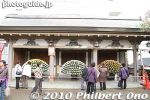
At the top of the steps are structures housing elaborate chrysanthemum displays.
|
|
|

The path to the shrine's Honden main hall is lined with more chrysanthemums.
|
|

In the background is the roof of the Honden main hall.
|
|
|
|
|
|
|
|
|

Adjacent to the Honden is this building with more chrysanthemums.
|
|
|

The design of the Imperial Family crest is based on this type of chrysanthemum.
|
|
|

Yushima Tenjin Shrine was one of Hiroshige's "100 Views of Edo" ukiyoe primt series. Honden main hall during the Chrysanthemum Festival in Nov. Bunkyo- Ward, Tokyo.
|
|
|
|

The Honden is flanked by chrysanthemums displayed in the kengai-zukuri style. 懸崖作り
|
|
|
|

Praying at Yushima Tenjin Shrine's Honden.
|
|
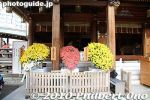
At the Honden, chrysanthemums displayed in the kengai-zukuri style where smaller flowers slope downward. 懸崖作り
|
|

Small red chrysanthemums displayed in the kengai-zukuri style. 懸崖作り
|
|

Facing the Honden is this massive collection of wooden prayer tablets written with the donor's prayers. Most of them are bought/written by students praying to pass school entrance exams.
|
|
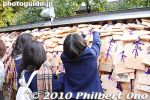
High school girls tie on a wooden tablet (called ema).
|
|

This wooden ema votive tablet wishes for entrance to Harvard University.
|
|

Yushima Tenjin Shrine ema tablet.
|
|

Near the Honden is the shrine office where you can apply to have a private prayer in the shrine hall.
|
|

Next to the shrine office are more chrysanthemums. They are exhibited in a half-globe shape called Oozukuri. 大作り
|
|

Yushima Tenjin Shrine also has life-size chrysanthemum dolls.
|
|

These chrysanthemum dolls are based on the current NHK Taiga Drama TV series called "Ryoma-den," about Sakamoto Ryoma.
|
|

Sakamoto Ryoma and wife Oryo as chrysanthemum dolls called kiku ningyo. Yushima Tenjin Shrine, Tokyo 菊人形
|
|

Sakamoto Ryoma chrysanthemum doll at Yushima Tenjin Shrine, Tokyo.
|
|
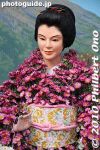
Wife Oryo chrysanthemum doll.
|
|

Very well done, and it makes this chrysanthemum festival unique. Yushima Tenjin Shrine, Tokyo.
|
|

Another scene from Ryoma-den.
|
|
|

Ryoma bears a resemblance to Fukuyama Masaharu who portrays Ryoma in the TV series.
|
|

Notice the Black Ships (Kurofune) in the background. Yushima Tenjin Shrine, Tokyo.
|
|

Chrysanthemums exhibited in a half-globe shape called Oozukuri. 大作り
|
|

Closeup of chrysanthemums exhibited in a half-globe shape called Oozukuri. 大作り
|
|
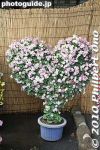
Heart-shaped chrysanthemums.
|
|

Beyond the dolls is this building with bonsai chrysanthemums.
|
|

Bonsai chrysanthemums.
|
|

Bonsai chrysanthemums.
|
|
|
|

Yushima Tenjin Shrine's Omote Torii, made of bronze, was built in 1667.
|
|

Path from Omote Torii to the Honden.
|
|

Yushima Tenjin Shrine and torii monuments.
|
|

Path from Omote Torii to the Honden. On the right is the Yushima Tenjin Museum. 宝物殿
|
|

The path is also lined with more chrysanthemums.
|
|

Chrysanthemums shaped like Mt. Fuji. Capped by white flowers for snow. Yushima Tenjin Shrine, Tokyo.
|
|

Peacock chrysanthemum displays in a bontei display. 盆庭
|
|

Peacock chrysanthemum display.
|
|

Lion dog on a pedestal with a plum blossom design.
|
|

Bull statue at Yushima Tenjin Shrine.
|
|
|

Receive advice here for growing chrysanthemums.
|
|

Plum trees. These will bloom in Feb.
|
|

Plum tree monument.
|
|

Notice the huge wooden prayer tablets.
|
|
|
|
|

Chrysanthemums displayed in the kengai-zukuri style. 懸崖作り
|
|

Chrysanthemums displayed in the kengai-zukuri style. 懸崖作り
|
|

Chrysanthemums displayed in the kengai-zukuri style. The wooden plaque has the name of the sponsoring company. 懸崖作り
|
|

Behind the Honden is this building also full of chrysanthemums.
|
|

A small shrine called Togakushi Shrine.
|
|

Togakushi Shrine.
|
|

Chrysanthemum tiger at Togakushi Shrine.
|
|
|
|
|
|
|
|
|
|
|
|

A trio of chrysanthemum plants in a single pot is called bon'yo. 盆養
|
|
|
|
|
|
|
|

This species, called Tomoe Nishiki (巴錦), is especially regal-looking with petals deep-red on the inside and gold on the outside.
|
|
|
|
|

Chrysanthemums exhibited in a half-globe shape called Oozukuri. The semi-globe usually has six circular rows. 大作り
|
|

Chrysanthemums exhibited in a half-globe shape called Oozukuri. The flowers are already withering. 大作り
|
|

Signs explaining the species are also provided. Nothing in English though.
|
|

Behind the Honden.
|
|
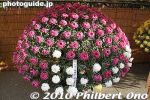
Chrysanthemums exhibited in a half-globe shape called Oozukuri. 大作り
|
|

Chrysanthemums exhibited in a half-globe shape called Oozukuri. 大作り
|
|

Tomoe-nishiki chrysanthemums exhibited in a half-globe shape called Oozukuri. 大作り
|
|
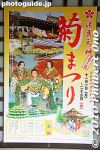
Yushima Tenjin Chrysanthemum Festival poster
|
|

Steps called Otoko-zaka or Male Slope. This was where many geisha went back and forth between their geisha quarters during the Edo Period.
|
|
|
|
|
|






